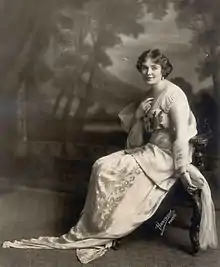| Cheating Cheaters | |
|---|---|
| Written by | Max Marcin |
| Date premiered | August 9, 1916 |
| Place premiered | Eltinge Theatre |
| Original language | English |
Cheating Cheaters is a 1916 play written by Max Marcin. Producer A. H. Woods staged it on Broadway. The play is a melodramatic farce about two groups of jewel thieves who are each posing as a wealthy family in order to rob the other.
Plot
Nan Carey becomes a member of a group of jewel thieves who pretend they are the wealthy Brockton family in order to gain the confidence of real high society families. While traveling, Nan (using the name Ruth Brockton) attracts the romantic attention of Tom Palmer, who turns out to be one of the Brocktons' neighbors. While attending a tea party thrown by the Palmers, the Brockton gang tricks the Palmers into inviting Nan to stay with them while the rest of the Brocktons are supposedly visiting Chicago. The Brocktons expect this ruse will allow them to steal the Palmers' jewelry. It is then revealed to the audience that the "Palmer family" is another group of thieves, who are planning to steal the Brocktons' jewelry while the Brocktons are out of town.
Thinking the Brocktons have left, the Palmer gang slips into the Brockton mansion, but are captured by the Brocktons. Meanwhile, Nan has gone to the Palmer mansion to burglarize it. Upon her return, the two groups each realize the other is a criminal gang, and they decide to join forces. Their planning is interrupted by detectives from the Ferris Detective Agency, who capture the combined gangs on behalf of the insurance companies for their past victims. Nan is revealed to be Ruth Ferris, head of the agency, who has been working undercover posing as a thief. Because her love for Tom is real and not just part of her cover, she offers him the opportunity to confess and join her agency rather than be turned over to the police.
Productions
The play appeared in a preview production at the Savoy Theater in Asbury Park, New Jersey in June 1916.[1] It debuted on Broadway on August 9, 1916, at the Eltinge 42nd Street Theatre, where it ran for over eight months with 286 performances.[2][3] The production closed on April 14, 1917.[4] After the Broadway run it went to London's West End, opening at the Strand Theatre in February 1918 with Shirley Kellogg playing Nan.[5]
Cast and characters

The characters and cast from the Broadway production are given below:
| Character | Broadway cast[6] |
|---|---|
| Steve Wilson | Robert McWade |
| Antonio Verdi | Edouard Durand |
| George Brockton | William Morris |
| Nell Brockton | Anne Sutherland |
| Nan Carey/Ruth Brockton | Marjorie Rambeau |
| Ira Lazarre | Frank Monroe |
| Mrs. Palmer | Winifred Harris |
| Grace Palmer | Gypsy O'Brien |
| Tom Palmer | Cyril Keightley |
| Edward Palmer | Arthur Barry |
| Phil Preston | William J. Phinney |
| Myron T. Hanley | Fletcher Harvey |
| Holmes | William Riley Hatch |
Reception
The New York Times gave a positive review, saying it was "an interesting play that is entertaining all the way through".[6] The review in The Brooklyn Daily Eagle was also positive, calling the play "ingenious, clever and surprising".[7] In The Theatre, Arthur Hornblow praised the play as "delightful entertainment".[8]
In The Evening World, reviewer Charles Darnton called the Eltinge Theatre the "temple of crook-drama" with Woods as its high priest. He said Marcin had written a well-executed version of a common story, but it was entertainment "of the moment" that served only to pass an evening.[9]
Adaptations
_-_Ad_1.jpg.webp)
In 1919, actress Clara Kimball Young produced a silent film based on the play, retaining the title Cheating Cheaters. She also co-starred with Jack Holt. Allan Dwan directed. This version is now considered a lost film.
A second silent film adaptation, also titled Cheating Cheaters, was released by Universal Pictures in 1927. It starred Betty Compson and Kenneth Harlan. Edward Laemmle directed.
Universal released a sound film adaptation in 1934, starring Fay Wray and Cesar Romero. It again kept the title Cheating Cheaters. Richard Thorpe directed.
On August 31, 1936, the Lux Radio Theatre presented a radio adaptation, starring June Lang and George Raft.[10]
References
- ↑ "Cheating Cheaters Opens". Brooklyn Daily Eagle. Vol. 76, no. 171. June 20, 1916. p. II.4 – via Newspapers.com.

- ↑ Bordman, Gerald (1995). American Theatre: A Chronicle of Comedy and Drama, 1914-1930. New York: Oxford University Press. p. 47. ISBN 0-19-509078-0.
- ↑ Hischak, Thomas S. (2009). Broadway Plays and Musicals: Descriptions and Essential Facts of More Than 14,000 Shows through 2007. Jefferson, North Carolina: McFarland. p. 77. ISBN 978-0-7864-3448-0.
- ↑ "Theatrical Notes". The New York Times. Vol. 66, no. 21, 616. March 31, 1917. p. 9.
- ↑ Parker, John, ed. (1922). Who's Who in the Theatre: A Biographical Record of the Contemporary Stage (4th ed.). Boston: Small, Maynard & Company. p. 448.
- 1 2 "Cheating Cheaters Most Entertaining". Vol. 65, no. 21, 383. August 10, 1916. p. 7.
- ↑ "Cheating Cheaters a Decided Success". The Brooklyn Daily Eagle. Vol. 76, no. 221. August 10, 1916. p. 7.
- ↑ Hornblow, Arthur (September 1916). "Mr. Hornblow Goes to the Play". The Theatre. Vol. 24, no. 187. pp. 137–138.
- ↑ Darnton, Charles (August 10, 1916). "The New Plays: Cheating Cheaters a Trick Crook Play". The Evening World. p. 7.
- ↑ Billips, Connie J. & Pierce, Arthur (1995). Lux Presents Hollywood: A Show-by-show History of the Lux Radio Theatre and the Lux Video Theatre, 1934–1957. Jefferson, North Carolina: McFarland & Company. p. 119. ISBN 0-89950-938-X. OCLC 30398765.